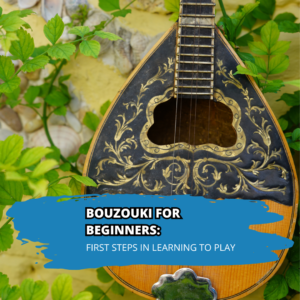Bouzouki for Beginners: First Steps in Learning to Play

The bouzouki, a stringed musical instrument with Greek origins, is central to the traditional music of Greece. With roots tracing back to the Byzantine era, the bouzouki has evolved through the ages, influencing and being influenced by the music of the regions it touched. This lute-like instrument, characterized by its long neck and pear-shaped body, produces a sound quintessential to Greek folk music. Its journey from a humble folk instrument to a symbol of Greek national identity marks the bouzouki’s profound cultural significance. The instrument’s vibrant tones and dynamic range make it versatile in various music genres, from Rebetiko to contemporary music, embodying the spirit and resilience of Greek culture.
Understanding the Structure of the Bouzouki
The bouzouki is a marvel of musical craftsmanship, featuring a hollow wooden body that shapes its resonant sound. Typically, it has three or four double strings (courses), though the four-course version is more prevalent today. The instrument’s long neck, adorned with frets, allows for a wide range of notes to be played. The strings, traditionally made of steel, contribute to the bouzouki’s bright and penetrating sound. Understanding the structure of the bouzouki is crucial for beginners, as it lays the foundation for mastering the instrument, from tuning the strings to navigating the fretboard with precision.
Holding the Bouzouki Correctly
Proper posture and hand placement are essential for playing the bouzouki effectively and comfortably.
The Right Posture
Holding the bouzouki correctly is fundamental to playing comfortably and effectively. Beginners should focus on maintaining a relaxed yet upright posture, ensuring that the instrument is balanced and stable. The bouzouki should rest on the right thigh (for right-handed players), with the body of the instrument snug against the player’s stomach. This position allows for optimal access to the strings and fretboard, minimizing strain on the arms and hands. A proper posture not only prevents fatigue during long practice sessions but also enhances the quality of the sound produced.
Hand Placement and Comfort
The placement of the hands is critical in extracting melodious tones from the bouzouki. The left hand should grip the neck of the instrument, with the thumb positioned at the back of the neck for support. Fingers should be arched and poised above the strings, ready to press down on the frets. The right hand, responsible for strumming or picking, must be relaxed and hover over the strings near the sound hole. Ensuring comfort and correct hand placement is essential, as it directly affects the fluidity of playing and the ability to execute intricate techniques.
Mastering Basic Strumming and Picking Patterns
Strumming and picking are fundamental techniques that form the essence of the bouzouki’s sound.
Strumming Techniques for Beginners
Strumming is a fundamental technique where the player sweeps the pick over the strings to produce chords. Beginners should start with basic downstrokes, hitting all the strings in a downward motion. Once comfortable, they can progress to upstrokes, where the pick moves in the opposite direction. Practicing these movements slowly and steadily helps in developing a consistent rhythm. It’s important to stay relaxed and let the wrist guide the movement, ensuring a smooth and even sound.
Picking Patterns to Get You Started
Picking involves plucking individual strings and is essential for playing melodies or more intricate parts of a song. Beginners should familiarize themselves with the concept of alternate picking, where the pick moves in a down-up pattern across the strings. Starting with single-string exercises, players can gradually incorporate more strings and complexity into their picking patterns. Mastery of picking techniques adds a rich texture to the music and allows for greater expressive versatility.
Learning Simple Chords
Chords are the building blocks of music, and learning them is essential for playing songs and understanding musical compositions.
Major Chords for Beginners
Chords form the harmonic backbone of most songs, and learning them is a pivotal step in a beginner’s bouzouki journey. Major chords, characterized by their bright and happy sound, are a great starting point. Beginners should start with simple major chords, focusing on clean finger placement and smooth strumming. Regular practice of these chords not only improves dexterity but also instills an understanding of basic music theory and chord progressions.
Transitioning Between Chords Smoothly
Smooth chord transitions are crucial for maintaining the flow of a song. Beginners should practice moving between chords efficiently, minimizing the movement of the fingers. Starting with two-chord progressions and gradually adding complexity is an effective approach. It’s important to practice transitions slowly, ensuring clarity and precision before increasing speed. This skill is fundamental to playing songs seamlessly and with confidence.
Playing Your First Songs
Playing songs is where the joy of learning the bouzouki culminates.
Easy Songs to Begin With
Starting with easy songs allows beginners to apply their skills in a musical context, providing a sense of accomplishment and motivation. Simple songs with repetitive chord progressions and rhythms are ideal for beginners. These songs enable new players to focus on the basics of timing, chord changes, and strumming patterns, building a solid foundation for more complex pieces in the future. For instance, traditional Greek songs like ‘Kokkino Garifallo’ or ‘Samiotissa’ come with straightforward chord structures and a steady rhythm, making them perfect for novice bouzouki players.
Practicing and Progressing
Consistent practice is key to mastering the bouzouki. Beginners should set regular practice sessions, focusing on areas of difficulty and gradually increasing the complexity of their exercises. Recording practice sessions and listening back can provide valuable insights into areas needing improvement. Setting small, achievable goals helps in maintaining motivation and tracking progress. As skills develop, exploring diverse musical genres and playing styles can further enrich the learning experience and foster a deeper connection with the instrument.
Looking to Start Bouzouki Lessons?
Our music academy offers the perfect starting point for beginners. Our dedicated and experienced instructors provide personalized bouzouki lessons, tailored to suit your individual pace and musical preferences. With a focus on building a strong foundation, our curriculum covers everything from the basics of holding the instrument and mastering fundamental chords, to playing your first songs and refining your technique. Our supportive learning environment and hands-on approach ensure an enriching and enjoyable learning experience, making our academy the ideal place to discover your passion for the bouzouki and unlock your musical potential. Join us!
FAQs
1. How long does it typically take for a beginner to learn the basics of playing the bouzouki?
The time it takes to learn the basics varies by individual, but with regular practice, a beginner can start to play simple songs and chords within a few months.
2. Can the bouzouki be used to play other genres of music apart from Greek traditional and Rebetiko?
Yes, the bouzouki’s versatile tones and dynamic range make it suitable for various music genres, from traditional Greek music to contemporary styles, allowing musicians to explore a wide array of musical landscapes.
3. Are there electric versions of the bouzouki for modern music genres?
Yes, electric versions of the bouzouki exist and are used in various modern music genres, offering amplified sound and the possibility to use effects, thus expanding the instrument’s versatility.
4. Is it necessary to learn to read music to play the bouzouki, or can one learn by ear?
While learning to read music can be beneficial, many bouzouki players learn by ear, especially in the traditional music context. Both approaches are valuable and can complement each other.
5. Are there different tuning options for the bouzouki, and how do they affect the sound?
Yes, the bouzouki can be tuned in different ways, commonly in CFAD or GDAE. Different tunings can offer a variety of sound textures and facilitate playing different types of music.
6. How does one choose the right pick for playing the bouzouki?
The choice of pick depends on personal preference and playing style. Beginners might start with a medium-thickness pick and experiment with different materials and thicknesses to find what feels comfortable and suits their sound preference.






